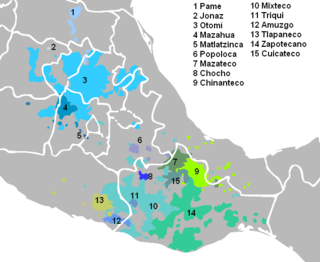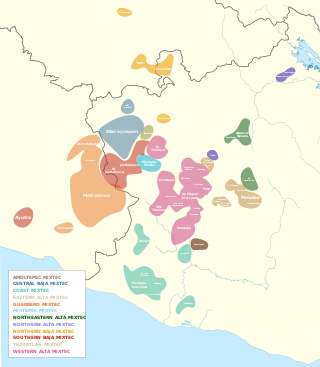Related Research Articles

The Mixtecs, or Mixtecos, are Indigenous Mesoamerican peoples of Mexico inhabiting the region known as La Mixteca of Oaxaca and Puebla as well as La Montaña Region and Costa Chica Regions of the state of Guerrero. The Mixtec culture was the main Mixtec civilization, which lasted from around 1500 BCE until being conquered by the Spanish in 1523.

The Mazatecan languages are a group of closely related indigenous languages spoken by some 200,000 people in the area known as the Sierra Mazateca, which is in the northern part of the state of Oaxaca in southern Mexico, as well as in adjacent areas of the states of Puebla and Veracruz.

The Mixtec languages belong to the Mixtecan group of the Oto-Manguean language family. Mixtec is spoken in Mexico and is closely related to Trique and Cuicatec. The varieties of Mixtec are spoken by over half a million people. Identifying how many Mixtec languages there are in this complex dialect continuum poses challenges at the level of linguistic theory. Depending on the criteria for distinguishing dialects from languages, there may be as few as a dozen or as many as fifty-three Mixtec languages.

Mixtec writing originated as a logographic writing system during the Post-Classic period in Mesoamerican history. Records of genealogy, historic events, and myths are found in the pre-Columbian Mixtec codices. The arrival of Europeans in 1520 AD caused changes in form, style, and the function of the Mixtec writings. Today these codices and other Mixtec writings are used as a source of ethnographic, linguistic, and historical information for scholars, and help to preserve the identity of the Mixtec people as migration and globalization introduce new cultural influences.
San Bartolo Soyaltepec is a town and municipality in Oaxaca in south-western Mexico. The municipality covers an area of 70.17 km². It is part of the Teposcolula District in the center of the Mixteca Region.

The Cuenca del Papaloapan Region is in the north of the Mexican state of Oaxaca, where the foothills of the Sierra Madre de Oaxaca meet the coastal plain of Veracruz. The principal city is San Juan Bautista Tuxtepec, the second largest in the state of Oaxaca.

The internal classification of Mixtec is controversial. Many varieties are mutually unintelligible and by that criterion separate languages. In the 16th century, Spanish authorities recognized half a dozen lenguas comprising the Mixtec lengua. It is not clear to what extent these were distinct languages at the time. Regardless, the colonial disintegration of the Mixtec nation and resulting isolation of local communities led to the rapid diversification of local dialects into distinct languages. Below are some attempts at Mixtec classification by various scholars.
Silacayoapan is one of the more extensive Mixtec languages. It is spoken by 150,000 people in Puebla and across the border in Guerrero, as well as by emigrants to the United States.
Tilantongo (Diuxi-Tilantongo) Mixtec is a Mixtec language of Oaxaca. It is not close to other varieties of Mixtec. Numbers are declining due to emigration to the United States.
Soyaltepec Mazatec is a Mazatecan language spoken in the Mexican state of Oaxaca, notably in the towns of Santa María Jacatepec and San Miguel Soyaltepec, and on Soyaltepec Island.
Chigmecatitlán Mixtec is a Mixtec language of Puebla, Mexico, spoken in the municipalities of Chigmecatitlán and Acatlán de Osorio. This language is also known as Central Puebla Mixtec, Chigmecatitlán Mixtec, Mixteco de la Frontera Puebla-Oaxaca, and Mixteco de Santa María Chigmecatitlán.
Zacatepec Mixtec, or Tacuate, is a Mixtec language of Oaxaca. It is spoken in the town of Santa María Zacatepec and other towns in Oaxaca, Mexico.
Ixtayutla Mixtec is a Mixtec language of Oaxaca. It is close to Chayuco and Zacatepec Mixtec.
Tututepec Mixtec is a Mixtec language of Oaxaca, spoken in Santa María Acatepec, Santa Cruz Tututepec, San Pedro Tututepec and other towns. It is not close to other varieties of Mixtec.
(Magdalena) Peñasco Mixtec, also known as Tlacotepec Mixtec, is a Mixtec language of Oaxaca spoken in the towns of Santa María Magdalena Peñasco, San Cristobal Amoltepec, San Mateo Peñasco, and San Agustín Tlacotepec. It has closer unidirectional intelligibility with other varieties, but may be closest to Ñumí Mixtec.
Tidaá Mixtec is a moribund Mixtec language of Oaxaca. It is not close to other varieties of Mixtec.
Mixtepec Mixtec is a Mixtec language that is spoken in the lower Mixteca region. Mixtec language is largely spoken in the area of San Juan Mixtepec, district of Juxtlahuaca, state of Oaxaca. However, the language is also spoken in other areas including Tlaxiaco, San Quintín Baja California, Santa María California, and Oregon. In 2004, it was reported that approximately 12,000 people spoke the Mixtepec Mixtec language. While most speakers of the language refer to it as 'sa'an ntavi' meaning 'language of the poor' or 'poor people's language,' others refer to it as 'sa'an save' which means 'rain language.' It is not closely related to other varieties of Mixtec.
Chazumba Mixtec is a Mixtec language of Puebla and Oaxaca, spoken in the towns of Santiago Chazumba, San Pedro y San Pablo Tequixtepec, Zapotitlán, Santa Gertrudis Cosoltepec, Petlalcingo, and Totoltepec de Guerrero.
Southern Puebla Mixtec, denominated by INALI as Puebla-Oaxaca borderline Mixtec, and also known as Acatlán Mixtec, is a Mixtec language of Puebla and Oaxaca State in Mexico. It is spoken in the towns of Acatlán, Xayacatlán de Bravo, San Jerónimo Xayacatlán, Petlalcingo, and Zapotitlán Palmas.
Soyaltepec may refer to:
References
- 1 2 Soyaltepec Mixtec at Ethnologue (18th ed., 2015) (subscription required)